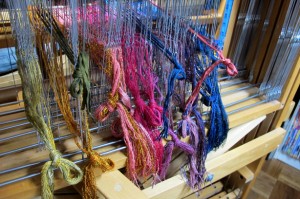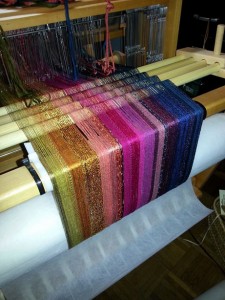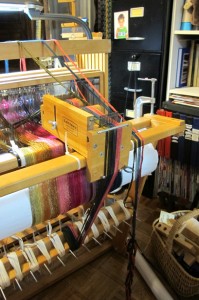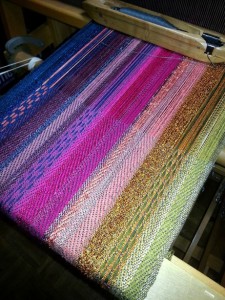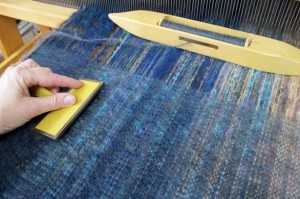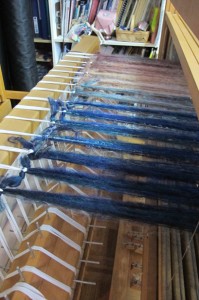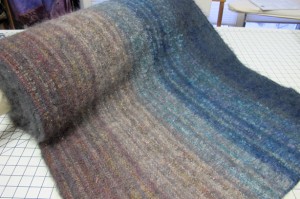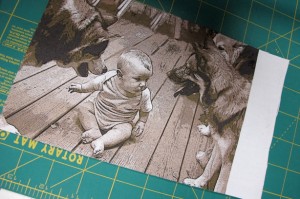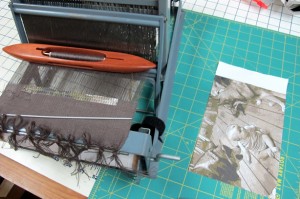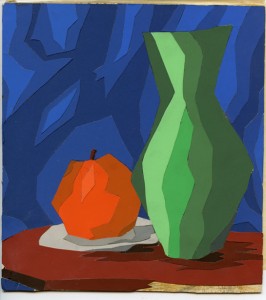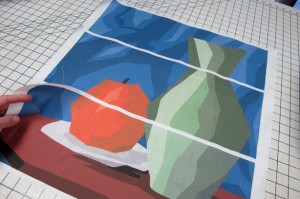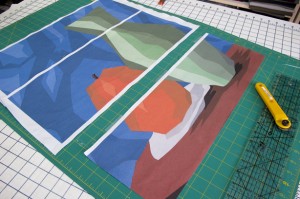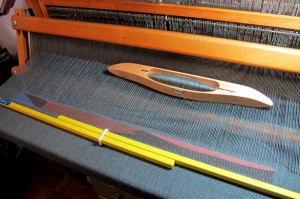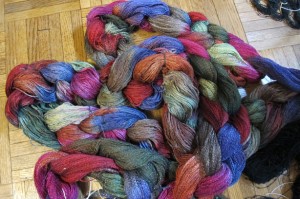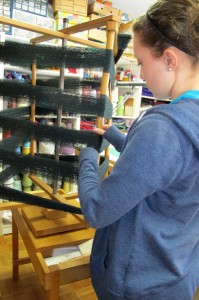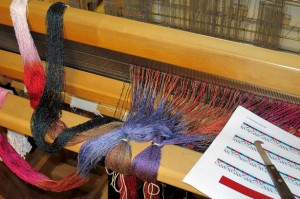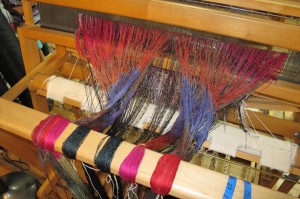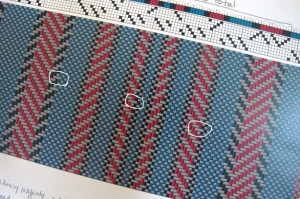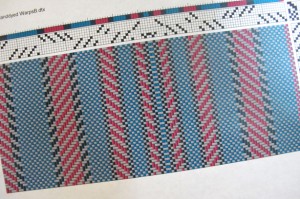Or maybe it is C or D, I’ve lost track.
But I’m getting ahead of myself. It has been a busy snowbound week here in NJ.
I threaded the scarf warp.
I beamed the scarf warp.
I put the supplemental warps on the lower warp beam.
I started weaving the scarf warp. Can I say what a breath of fresh air all the color in this scarf brings to such gray miserable weather?
Meanwhile…
I finally just sat down one day over the weekend and wove off the mohair yardage that has been taking up valuable loom space for more than a year. It was a twelve yard warp and I’ve netted about 10 yards. I carefully brushed the warp before I advanced each section of cloth.
Within a couple of hours the knots came creeping up over the back beam.
The fabric is washed and dried and rolled and even though the photo looks fuzzy, that’s actually the fabric, it is hazy and gorgeous to touch and puffy and light and I absolutely can’t wait to sew it up. Worth the wait.
Meanwhile…
In anticipation of my trip to Florida next month for the Florida Tropical Weaver’s Conference, more because I want to think about Florida with all this raging snow up here in the northeast, I have to start prepping and planning for the workshop I’m teaching there, called Weave a Memory. Participants will bring photos and I’ll scan them into the computer, adjust in Photoshop and print on fabric, which will then be cut into strips and rewoven back together in an inlay technique. I plan to fly down with one of my little Stucto’s set up for a demo, however I needed this particular Structo for the beginning weaving class I taught last month. So I keep a spare castle threaded specifically for the Theo Moorman inlay technique I use, with warp wound onto spools, and I keep that stored for when I need the loom for a class like Weave a Memory. I pulled the old castle from the Structo, and replaced it with the one that was pre-threaded with 14/2 linen. I slipped the warped spools onto the hex beam after removing the apron I made for it, and then just had to sley the reed. I printed a photo I’ve wanted to do for awhile, a shot of my son as a baby surrounded by our three dogs. It is printed on treated cotton artist’s canvas. It was the Christmas card image for his first Christmas. So that is underway.
Meanwhile…
All the large works I’ve done in this technique have either been sold or given to family members or are in frames too large to get in my baggage to Florida. So I need to weave a large piece that can be rolled up and taken with me next month. I found this small color study I did in a college color studies class back in 1974. I’ve always loved the image, made from inlaid pieces of Color-Aid paper, and even though the professor thought it was conventional in the color usage, she said it was well balanced and handled and nicely done. I got a B.
I scanned it into the computer and spent a lot of hours a few months ago, digitally repairing the missing pieces of Color-Aid that had fallen off and disappeared. I cleaned up edges and then enlarged this little 6″ still life into a 20″ still life. I split the image into three sections and printed them on 8 1/2″ rolls of treated cotton Percale. Once it is cut into strips, you’d never know it was actually printed in three panels.
I got the table loom ready to go, I keep this one threaded as well for this technique. I started cutting the first panel into strips, one at a time. I started weaving the strips back together. This is the first time I’ve used cotton, and I’m not sure the colors are as rich as I’d like, but we will see when it is all finished.
Meanwhile…
In my quest to empty looms, (I’ve only got one of my shaft looms left to clear), I’m conscious of the naked loom syndrome, so I want at least a couple with something fun on them, something colorful, so when I’m in the mood to weave, there is actually something to weave. It isn’t good to have naked looms. I’ve got the scarf warp well underway, but there was this beautiful warp that has been artfully draped over my 36″ loom since dye day at the guild last August. I really wanted to get that yardage going.
I spent a number of hours writing a draft, a simple combination of twill and plain weave, using most of both of the warps, one a rayon slub and the other a rayon/silk from Silk City, the old Contessa. They are very different and will create different surfaces on the cloth. To make the cloth a bit wider, I decided to add an additional commercial element and this dark green rayon novelty jumped off the shelf at me. I had my trusty intern wind me a warp of 196 ends.
I got her started on sleying the reed, and this was pretty complicated. There are three ends in each dent, and she had to pay close attention to what was happening while carefully combining the three warps. I worked with her so there were no mistakes and took over when it was time to leave. I finished it up this morning and really really wanted to see it threaded.
That’s when the trouble started.
Actually threading the loom wasn’t bad, I had to pay attention but everything was going swimmingly well until I started really looking at the draft I was using. Something wasn’t right. I blew up the drawdown and studied it closely and found there were a couple of transitions that I just wasn’t happy with. I’ve circled the problem areas.
I went back to the computer and worked for another couple hours, there are two issues to work around, one is that this warp is already sleyed in the reed, and there is no way I’m taking 700+ ends from three different ten yard warps and pulling them out, and the other is I spent a lot of time working out the original draft using Fibonacci numbers. I wanted to maintain that. So the color sequence and spacing had to stay the same. Only the threading could change. Because of the Fibonacci numbers, the draft can’t technically mirror itself unless I add an additional thread in the middle of each repeat, and I don’t have any more to add, and I’m not changing the layout in the reed, so I reworked the transition of the twill and plain weave areas and ended up with a double thread in the dead center of each repeat, which could actually be kind of cool. Or not. Only one way to find out. Thread it and weave it and hope for the best.
So now I have to rethread about about 200 ends that are already threaded, but that’s only a few hours of work and I’ll tackle that tomorrow. I like the transitions better between structures, they are tighter and cleaner. And I used a broken twill transition between the larger twill areas and their dark green borders.
Stay tuned…
